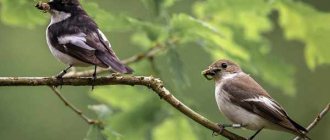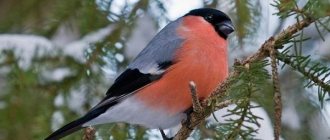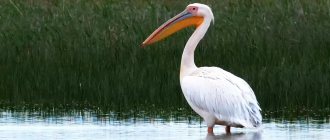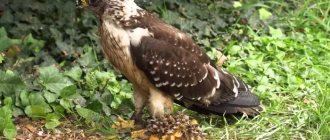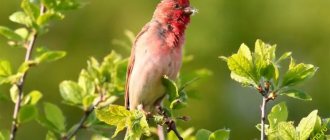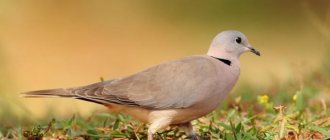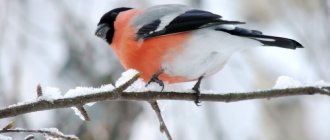The Robin or Robin is a common bird species in Europe and often visits orchards. The bird lives alone outside the breeding season, in winter it moves to people's residences and begs for bread crumbs at doors. Robins consume insects, worms, fruits, and seeds. Sung at dawn, as soon as spring begins, the melodic song enchants, even if it wakes you up early in the morning!
This species stays for the winter or migrates, depending on the region of residence. In spring, the robin builds a nest among vegetation, hiding it in ivy, hedges or dense foliage of a bush. It is a territorial bird that defends its nesting territory from other species and even from other robins. The battles are brutal and sometimes end in the death of one fighter.
Physical characteristics of robins:
- body length 14 cm;
- wingspan 20-22 cm;
- weight 15-20 g.
The species lives in nature for up to 10 years.
Description of the robin's appearance
This bird is interesting to watch. Females and males are similar. The crown, back of the head and upper body, including the wings and tail, are soft brown. Sometimes a not clearly defined black stripe is visible on the wing.
The head, throat and chest are bright red-orange, edged with gray feathers, except for the forehead. The underparts are whitish, the sides are pale reddish brown.
The beak is dark. The eyes are dark brown. Thin legs are pinkish-brown.
Juveniles are generally brown. The underparts are paler, with mottled beige or pale brown spots. Red-orange feathers will appear only after the first moult, after about two months.
Origin of the species and description
Photo: Zaryanka
The common robin Erithacus rubecula belongs to the animal kingdom, phylum Chordata, order of passerine birds. This group is considered one of the largest in the world and includes about five thousand representatives. The Robin belongs to the thrush flycatcher family Muscicapidae. Birds of this species live in countries with warm climates. They are migratory birds.
Video: Robin
Representatives of this family are distinguished by the following features:
- All birds of this family are small in size. Adult birds range in size from 10 to 30 cm in length;
- birds have a straight beak;
- wide, rounded wings;
- birds have a rather long straight tail;
- They live in forests, bushes, and parks.
The color of the Robin bird is light and bright. On the chest and lower part of the muzzle the feathers are bright red, on the back and on the wings the bird is light gray with a greenish tint. The feathers on the bird's belly are light. The plumage on the throat, chest and sides is red. Depending on the subspecies, the color of the bird may be brighter or darker. Robins of the northern subspecies are much larger, and their colors are brighter than their southern counterparts. This species was first described by the Swedish naturalist Carl Linnaeus in 1758 in his work under the name Motacilla rubecula.
How the robin sings
The typical call is a clear "tick", repeated and spoken in short series of "tick-tick-tick..." by young and adult birds. The robin also makes a short, quiet or shrill and plaintive call of "siii" when alarmed or in danger.
The robin's song is a series of sound phrases, soft, clear sounds and sharp short trills.
The robin sings mainly to attract a female and to mark territory early in the morning while sitting on a pole. Sometimes he sings at night if he is near a street lamp. The robin sings all year round, except in late summer when it molts. In autumn the singing is softer, even a little melancholy.
Video recording of the robin's voice is at the bottom of the article.
Appearance and features
Photo: Robin bird
The robin is a very small bird, about 14 cm in length. The weight of an adult is only 15 grams, the wingspan is from 17 to 20 cm. The bird's feathers are quite delicate and soft, and they do not adhere to the body, which is why the robin looks rather round. The robin has long, strong legs with which it jumps very quickly on the ground. It has the habit of stopping abruptly while moving and making several bows while sharply shaking its tail.
Males and juveniles are brighter in color than females. Newborn birds of this species do not have a bright red spot on the chest; it is formed later. The bird's head is small, its eyes are small black. The beak is straight. The bird has good eyesight and easily navigates forest thickets at night.
Also, robins produce uneven beautiful trills, which over time turn into a quieter and less intelligible chirping. The song does not have any specific length. The song consists of gentle hissing sounds. The song is periodically interrupted by sharp pauses. Birds sing in the evening at dawn, which is why this bird got its name, Robin. The average life expectancy of robins is 1.5-2 years, but this is mostly due to the fact that many young birds die early. Sometimes these birds can live 10 years in the wild.
Robins are migratory birds, they can cover long distances, but if bad weather catches the birds on the way, they can die. In warm regions, birds can lead a sedentary life if the conditions suit them.
Where do robins live?
The bird lives in:
- forests;
- landings;
- hedges;
- parks;
- gardens
Robins are often seen in various types of bushes in open areas.
The robin lives in Europe and Great Britain. Birds found in the northern parts of their range migrate south in winter to North Africa, east of Siberia and Iran. The species is also present on the Atlantic islands such as Madeira, the Canary Islands and the Azores. Attempts to move the robin to other continents were unsuccessful.
Distribution and habitats
The common robin inhabits Europe, Western Siberia, the Caucasus, Asia Minor and North-West Africa. In tropical climates, the bird prefers to stay for the winter and leads a completely sedentary lifestyle.
The robin likes to settle near rivers and reservoirs - these can be parks, mixed forests, shrubs, and vegetable gardens.
Because of its friendliness, the robin often finds helpers among human beings. Children love to feed this bird, because it is not afraid to eat from their hands.
These are small, but not peaceful birds
Robins are aggressive when defending their territory. Disputes with other birds escalate into fierce, prolonged fights, with robins pecking and scratching each other. Both males look at each other, puff out their chests, and show red-orange feathers. The goal is to pin the opponent to the ground, which means defeat. Some fights sometimes end in the death of one of the participants.
Robins are capable of driving large birds away from their territory. She can also attack her own reflection if she sees red feathers. The bird inflates its plumage and lowers its wings when it engages in battle.
Behavior and diet
The robin eats small insects, spiders, small beetles, and bugs. Less commonly, the robin includes berries or seeds in its daily diet.
— Advertising —
The Robin is a very interesting bird that leads its own way of life, unlike anyone else. The bird hunts alone, and it also likes to sing without company. But the robin is a very friendly and peaceful bird - it will approach a person without fear, and can even eat from one’s hand. But for some reason he considers other birds to be his enemies. Robins can often get into fights in order to defend their territory. The big bullies are the males, and the females, on the contrary, are very gentle and caring. There are cases where a female robin took care of cuckoo chicks.
How robins prepare for mating season
Robins form pairs as early as January. Males and females live in the same territory until March, protecting it from the invasion of competitors. The male sings loudly for the chosen one, who is building a nest. During this period, he regularly brings nuptial feeding to his partner. But she quickly drives away the breadwinner. Indeed, the female is very nervous when she builds a nest, and the presence of a singing male next to her sometimes forces the robin to change the place where she builds the nest.
Female and male robin
Keeping at home
Who doesn't know the robin? There are legends about this songbird, it is described in books and remembered in songs. The robin is a favorite of many people, because it gives a unique song.
If you are planning to get this cute, feathered creature, then know that the robin is very friendly, it does not require special care or conditions. Robins quickly adapt in captivity. It’s hard to believe, but for a bird, the optimal living conditions will be a cage. The fact is that very often, the robin suffers due to the fact that it is prey for many larger predators. Foxes, ferrets, wild cats, stoats, martens, weasels - all these animals hunt the robin, moreover, they break its nests. In captivity, the robin will not know all this and will be safe.
Feeding robins
Feed the bird a mixture of living creatures, for example: larvae, beetles, dragonflies. Robins can also eat cereals and berries.
Cage requirement
For keeping it, it is better to choose a medium cage made of metal or wood. Place the bird's house in a sunny place - this will inspire the bird to sing. They reproduce well at home. The laying lasts for 14 days. Both parents incubate. Interestingly, the chicks are born without feathers. For about two weeks, the chicks are under the careful supervision of their parents. The first attempts to take off take place on the twentieth day after birth, and after a month the chicks become similar to adult birds and can leave the nest.
Eggs and chicks
A female can give birth to two offspring in a year. The most important year in a chick's life is its first year. It is at this moment that its immunity is formed, so the bird must be protected.
Life period
With very good care, a bird can live up to 12 years, but only at home. In the natural environment – 2 years.
Nesting and offspring of robins
The female builds the nest several meters above the ground, is well hidden among vegetation, and can also nest in a cavity or crevice in a stone wall and in strange places such as a mailbox or a pot buried in the ground!
The female begins construction at the end of March. The base of the nest is made of dry leaves and moss. Inside it is lined with dry herbs and roots, wool and feathers.
Robins usually lay 5 whitish eggs with dark markings. Incubation lasts about 13 days, the female incubates the nest herself. During this period, the mother regularly leaves the nest to feed, but the partner also brings food for her.
The shells of hatched eggs are immediately removed from the nest by the female, who sometimes eats part of the shell for calcium.
In the first week of life, the chicks are fed by their mother, and the male brings food to the nest for his partner. From the second week, the chicks are fed by both parents. Young robins leave the nest approximately two weeks after hatching, and the parents feed the brood for another 15 days.
During the breeding season, the female sometimes makes a second clutch in the same, but often in a new nest.
Social structure and reproduction
Photo: Robin in flight
Robins manage to lay eggs twice and raise chicks in one summer. The first time robins nest is in May, the second time is at the end of July. Sometimes, if something happens to the chicks, parents can try to raise their offspring in August. In mating games, the female takes the initiative. The female flies into the male's territory, defiantly opens her wings to the sides and begins to sing.
The male, while guarding the territory, begins to drive it away, making terrible scaring sounds. The male fluffs his wings, sways and shows that he does not want to see a stranger on his territory. After some time, the bird retreats, hiding behind a tree or bushes. Then she comes back and starts singing loudly. After 3-4 days, the male most often gives up.
The female builds a nest on her own; the size of a robin's nest is about 5 cm in height and 7 cm in width. She tries to hide the nest as best as possible. At one time the female produces 4-6 bluish eggs. The female incubates the eggs for two weeks, practically without getting up from laying; the male takes care of food.
After the chicks hatch, the parents protect them. The male brings food, and the female feeds the cubs. Chicks moult once at the age of one and a half to two weeks. Delicate down gives way to stiffer feathers, and a red color appears on the chest and belly. At the age of two weeks, young chicks are already able to fly and begin to get their own food.
What and how do robins eat?
The bird feeds mainly on insects and spiders, as well as fruits, berries and seeds in cold winters, and consumes earthworms.
At the beginning of summer, insects make up the majority of the diet; the robin also feeds on worms, snails, spiders, and other invertebrates. He eats fruits intensively (they make up about 60% of the diet all year round) and wild berries. Young birds hunt insects and earthworms.
Female and male
The Robin is a very unusual bird - it prefers solitude. Often you can see not a pair of these birds, but one male or female sitting on a branch. Robins do not like to bother one another, especially since they cannot stand the company of other birds. Males, in the excitement of defending their territory, are capable of fighting fiercely. Sadly, more than 10% of this species die due to fighting, either among themselves or with other bird species. All the best can be said about the female robin: caring, gentle, kind. This bird is capable of nursing other people's chicks, for example, cuckoo babies. In addition, the female alone takes care of the construction of the family nest, the male prefers to sing a song at this time. It is interesting that the stronger sex sings even in the evening, when all the birds do not mind sleeping.
Males like to stand out in everything, for example: he arrives much earlier than the female - in March, and the female - in early May.
Nutrition
The basis of nutrition is insects; their larvae are also suitable. Robins also enjoy feasting on spiders, worms and even small mollusks (snails). By mid-summer, when the berries are ripe, they include this “dessert” in the diet: in August they eat blueberries and buckthorn, and in the fall they switch to rowan, spruce seeds and elderberry.
In the spring, when plant food is not available, the central place in the diet is occupied by animal food - beetles, ants and other invertebrates. As follows from the description of the robin , it prefers not to fly too high, and therefore looks for food in the soil and the lower tier of trees. There are a huge variety of insect species consumed by these birds; they are not picky in this matter.
In late autumn, they often fly up to feeders near people’s homes and can start fights near the “buffet.” They are unpretentious in this matter and take well to feed mixtures. Soft food is their absolute priority; they like to eat plenty and often.
However, this method of feeding is not always convenient for them - their paws are not designed to cling to the edges of feeders. Wide windows or free pallets in the structure are perfect for them. You can also simply sprinkle the food on an open surface.
If you train a robin to eat near your house, in the morning you can enjoy its quiet but very melodic singing. Especially contact individuals may even allow themselves to be stroked, happily basking in the hands of a person.
In the summer, they often fly up to gardeners and gardeners, looking for seeds, earthworms and other insects that are unnecessary when sowing. Thus, it even slightly helps to increase productivity. These birds are very popular in England, where, according to some sources, it is considered the national bird. Thanks to its bright color, it was also awarded the title of Christmas symbol.
Interesting Facts
- The robin is a paradoxical bird: it does not like the company of birds, but it feels very comfortable near humans.
- The bird does not like open space; it loves to settle in thickets and bushes.
- In Great Britain, the Robin is a bird of great honor. You can often see an image of this bird on English stamps, because it is a symbol of Great Britain.
- About 10% of robins die in fights among themselves.
- The bird got its cute name because of its early singing - the robin sings with the appearance of the first dawn. Sometimes the bird can be heard in the evening.
- There is a legend among the people that the robin served the Virgin Mary at the birth of Jesus - she collected material for kindling a fire, and supported its flame with her wings - therefore her breast has a red spot and tan.
- It is interesting that the robin has every chance of living a long time in captivity, but in the natural environment it is in the danger zone.
